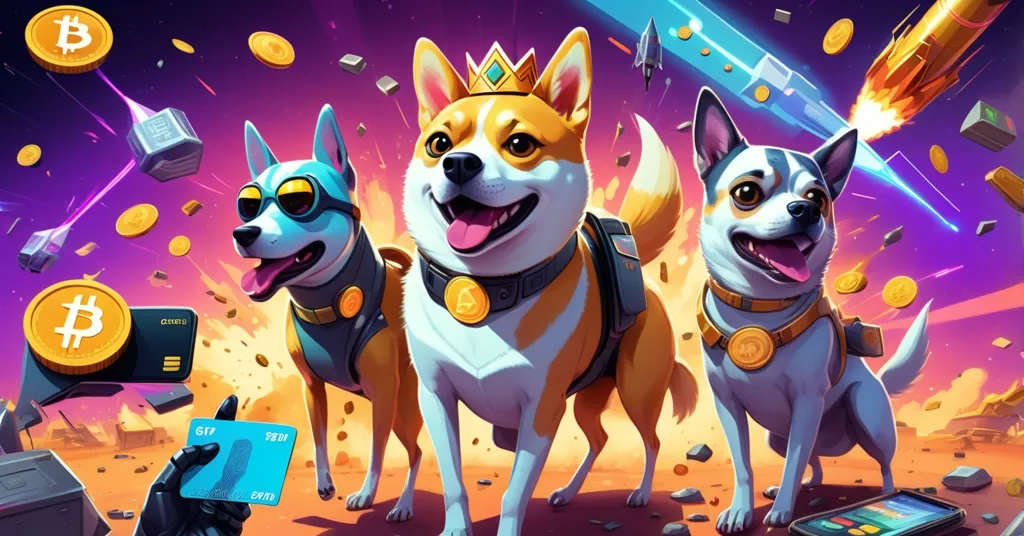GeeFi (GEE) vs. Ethereum (ETH) and Dogecoin (DOGE): Can This Newcomer Dominate by 2026?

Top Crypto Picks for 2026: Can GeeFi (GEE) Challenge Ethereum (ETH) and Dogecoin (DOGE)?
The cryptocurrency market is a rollercoaster of highs and lows, with giants like Ethereum (ETH) and Dogecoin (DOGE) facing significant hurdles while newcomers like GeeFi (GEE) promise to steal the spotlight. As we look toward 2026, a pivotal year for digital assets, can a presale hopeful like GeeFi really outshine established players, or is it just another flash in the pan?
- Ethereum’s Woes: Price swings and DeFi security flaws haunt ETH despite institutional backing.
- Dogecoin’s Dud: DOGE ETF launch flops with just $1.4M in volume, failing to ignite price growth.
- GeeFi’s Pitch: Marketed as a utility-rich ecosystem with wallets, staking, and a crypto card, hyped as a “100x gem.”
Setting the Stage for 2026
Why focus on 2026? The crypto space operates on cycles, with Bitcoin’s next halving—slashing mining rewards to boost scarcity—potentially driving a bull run around that time, much like past events in 2016 and 2020. Regulatory clarity, especially in major markets like the U.S., could either turbocharge adoption or stifle innovation. Meanwhile, mainstream interest continues to grow, with more businesses eyeing blockchain solutions. Against this backdrop, the performance of assets like Ethereum, Dogecoin, and emerging players like GeeFi will hinge on both tech fundamentals and market sentiment. Let’s break down where each stands and what they might offer by 2026.
Ethereum’s Persistent Challenges
Ethereum remains the kingpin of decentralized finance (DeFi) and smart contracts—self-executing agreements on the blockchain that power everything from lending platforms to NFT sales. But its crown is tarnished. Price volatility, often triggered by market-wide liquidations, keeps ETH on shaky ground. When Bitcoin sneezes, Ethereum catches a cold, with sharp sell-offs wiping out gains overnight. More troubling are the security breaches in its DeFi ecosystem. These platforms, built to cut out middlemen like banks, often fall victim to poorly coded smart contracts—think of them as buggy apps that hackers exploit to drain millions. High-profile hacks have cost users dearly, eroding trust.
Post-merge, Ethereum’s shift to proof-of-stake in 2022 aimed to cut energy use and set the stage for scalability through sharding—splitting the network into smaller chunks to handle more transactions. Layer-2 solutions like Arbitrum and Optimism already ease congestion, processing transactions off the main chain at lower costs. Institutional interest is rising too, with major firms betting on ETH as the backbone of Web3. Yet, until security tightens and scalability fully rolls out, Ethereum’s short-term outlook remains cloudy. For 2026, can it solidify its tech edge, or will persistent flaws let competitors close the gap?
Dogecoin: Meme No More?
Dogecoin, born as a joke with its Shiba Inu mascot, once rode a wave of internet hype to become a top crypto by market cap. Endorsements from Elon Musk and Reddit fervor turned it into a cultural phenomenon. But its latest milestone—a Dogecoin ETF launch—landed with the impact of a wet noodle. For those new to the term, an ETF, or exchange-traded fund, lets traditional investors buy exposure to DOGE without owning the coin directly. Yet, this ETF scraped together a measly $1.4 million in trading volume, a laughable figure compared to Bitcoin ETF debuts pulling in billions. The result? No price surge, no breakout past key resistance levels—just stagnation.
The community, once DOGE’s biggest strength, seems deflated on platforms like Twitter and Reddit after this flop. Musk’s influence, while still a factor, appears to be waning as his tweets no longer spark the frenzied rallies of 2021. Market cap trends paint a grim picture too, with DOGE struggling to hold relevance amid newer meme coins and utility-focused projects. By 2026, Dogecoin’s challenge is clear: evolve beyond a meme or risk becoming a relic of crypto’s past. Does it still have a loyal pack to carry it forward, or has the bark lost its bite?
GeeFi: Hype or Hope?
Enter GeeFi (GEE), the shiny new contender pitched as a financial ecosystem that could rival Ethereum and Dogecoin by focusing on real utility. At its heart is the GeeFi Wallet, a non-custodial setup where users hold their own keys—no third party can freeze or steal funds, unlike centralized exchanges that have collapsed like FTX. Supporting over 14 blockchains, it offers diversification, letting users interact with multiple networks without juggling wallets. Analysts are gushing, with some claiming it has:
“all the right ingredients to become the next $2 project.”
But let’s keep our feet on the ground—is this genuine potential, or just slick marketing for another presale? For a deeper look into predictions for these cryptocurrencies, check out this analysis of top crypto picks for 2026.
The presale itself is grabbing headlines. At $0.05 per GEE token, the project has raised over $300,000, selling 6.2 million tokens, with Phase 1 over 50% complete and a price hike looming. The hype machine touts it as a “100x gem,” suggesting a $1,500 investment could soar to $60,000 if GEE hits $2. Let’s be brutally honest: these projections are wild guesses, not guarantees. Crypto history is littered with presale stars that fizzled out—think 2017 ICO busts. Without transparency on the team, audits, or tokenomics, red flags loom large. Early investors might see gains if momentum builds, but caution is non-negotiable.
On a more tangible note, GeeFi’s staking program offers passive income with annual percentage rates (APRs) from 10% for flexible terms to a staggering 55% for a 12-month lock. Staking means locking tokens to help run the network—think validating transactions—and earning rewards, like interest in a savings account. Other options include 15% APR for 1 month and 22% for 3 months. Sounds juicy, but high yields often hide pitfalls like token inflation, where over-rewarding dilutes value. Remember Terra/LUNA’s collapse? Unsustainable APRs played a role. GeeFi’s model needs scrutiny to ensure it’s not a house of cards.
The roadmap is ambitious, promising the GeeFi HUB—a platform with a multichain decentralized exchange (DEX) for direct token swaps, portfolio tools, and an NFT marketplace for digital collectibles, though that hype has cooled since 2021. Most intriguing is the GeeFi Crypto Card, planned in VISA and Mastercard variants, for spending crypto in the real world with cashback perks. If executed, this could push decentralized tech into daily life, aligning with the drive for effective accelerationism to disrupt traditional finance. But crypto is full of broken promises—delivery is the ultimate test.
Broader Market Factors for 2026
Zooming out, the fate of Ethereum, Dogecoin, and GeeFi by 2026 won’t just depend on their tech or hype. Regulatory frameworks, especially in the U.S., could make or break crypto’s growth. Will we see clear rules for tokens as securities, or heavy-handed crackdowns? Central bank digital currencies (CBDCs), government-backed digital cash, loom as competitors—think China’s digital yuan—potentially siphoning interest from decentralized coins. Macro trends like inflation or recession could also drive or deter adoption; when fiat falters, Bitcoin and altcoins often shine as hedges, but fear can trigger sell-offs too.
Global adoption trends add another layer. If blockchain payment systems gain traction in developing economies, utility projects like GeeFi’s card could surge. But scams and rug pulls—where developers abandon projects after raising funds—remain a plague, especially for presale tokens. Ethereum’s DeFi exploits and Dogecoin’s meme volatility won’t escape regulatory eyes either. Navigating this maze will test every asset’s resilience.
Bitcoin’s Unshakable Shadow
Amid the noise of altcoin experiments, let’s not forget the bedrock of crypto: Bitcoin. As the original decentralized currency, BTC stands as a store of value and trustless money, a benchmark no altcoin can fully replace. Ethereum’s smart contracts, Dogecoin’s memes, and GeeFi’s utilities fill niches Bitcoin doesn’t aim to—nor should it. BTC’s simplicity and security are its strength. For 2026, while altcoins innovate, Bitcoin remains the ultimate safe harbor in a sea of speculation. Can GeeFi complement this ecosystem, or will it drown in its own ambition?
Risks and Rewards on the Horizon
Looking to 2026, the crypto landscape is a gamble of epic proportions. Ethereum’s tech prowess and institutional clout are offset by security gaps. Dogecoin’s cultural spark struggles to ignite financial fire. GeeFi’s utility focus and presale allure tempt risk-takers, but unproven projects are a dime a dozen. Bitcoin looms as the steady giant, reminding us why decentralization and freedom matter. In a market fueled by hype, your best weapon is skepticism—dig deep, question everything, even the shiniest new token. True progress in disrupting the status quo demands both bold innovation and brutal honesty.
Key Takeaways and Questions for Crypto Enthusiasts
- What obstacles are Ethereum and Dogecoin facing today?
Ethereum grapples with price volatility and DeFi security exploits, where hackers target flawed smart contracts, while Dogecoin’s ETF launch disappointed with only $1.4 million in volume, failing to drive price or investor excitement. - How does GeeFi aim to stand out against ETH and DOGE?
GeeFi positions itself as a utility-driven financial ecosystem with a non-custodial wallet, multi-chain support, staking, and a planned crypto card, marketed as a stable alternative to Ethereum’s tech woes and Dogecoin’s meme stagnation. - Is GeeFi’s presale a worthy investment opportunity?
Priced at $0.05 per token with over $300,000 raised, a $1,500 stake could hypothetically hit $60,000 at a $2 price, but such “100x gem” claims are speculative and riddled with risks given crypto’s history of presale flops. - What’s behind GeeFi’s staking rewards, and are they sustainable?
Offering APRs from 10% to 55% based on lock-up terms, GeeFi incentivizes holding for passive income, but high yields often signal risks like token inflation, as seen in past failures like Terra/LUNA. - Could GeeFi’s planned features boost mainstream crypto adoption?
With a multichain DEX, NFT marketplace, and VISA/Mastercard-compatible crypto card on the horizon, GeeFi could bridge digital and real-world finance, though execution remains a massive hurdle in a promise-heavy industry. - How does Bitcoin compare to these altcoin experiments?
Bitcoin stands as the unshakable store of value and decentralized money, while altcoins like Ethereum, Dogecoin, and GeeFi explore niches BTC doesn’t cover, complementing rather than replacing its foundational role. - What external risks could impact crypto by 2026?
Regulatory crackdowns, competing CBDCs, and macroeconomic shifts like inflation or recession could either propel crypto as a hedge or trigger sell-offs, affecting adoption for all assets from ETH to GEE.



